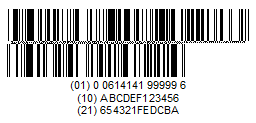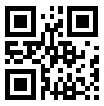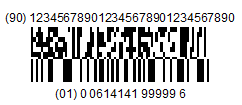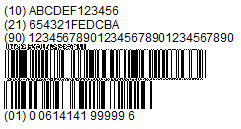Barcode Symbologies
A barcode symbology is the encoding scheme that is used to express data by using a pattern of bars and spaces in a barcode. The bars and spaces are the most basic elements of a barcode, and their arrangement is defined by the symbology that is used.
Symbologies can be divided into four categories based on technical specifications and one based on application specifications:
A linear symbology is a single row of bars and spaces. The elements can vary either by width (as in EAN-8) or by height (as in Royal Mail 4-State Customer Barcode).
|

EAN-8
|
|

Royal Mail 4-State Customer Barcode
|
Linear symbologies are also called one-dimensional (1-D) symbologies. Some linear symbologies support versions that are circular.
A two-dimensional (2-D) stacked symbology contains multiple rows of bars and spaces. Some 2-D stacked symbologies have separator rows between the data rows (such as GS1 Databar Expanded Stacked). Other 2-D stacked symbologies have no separator rows (such as PDF417).
|

GS1 DataBar Expanded Stacked
|
|

PDF417
|
A 2-D matrix symbology has a two-dimensional pattern of elements that does not necessarily have a row-by-row structure. Typically, the elements are squares or dots rather than bars, as in Aztec Code (in which the data is written in a spiral outward).
|

Aztec Code
|
|

DotCode
|
|

QR Code
|
A composite symbology has two components: a linear symbol (such as GS1 DataBar Limited) or 2-D symbol (such as GS1 DataBar Expanded Stacked) below a 2-D symbol. For GS1 composite symbols, a separator row always exists between the two components.
|

GS1 DataBar Limited
with CC-B
|

GS1 DataBar Expanded Stacked
with CC-A
|
Several "general-purpose" barcode symbologies have been adopted for use in various industries as specialized application standards to carry specific kinds of data. These symbologies include the following:









